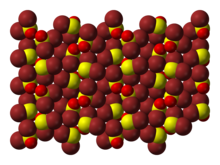| |||

| |||
| Names | |||
|---|---|---|---|
| IUPAC name Thionyl bromide | |||
| Other names Sulfur oxy dibromide | |||
| Identifiers | |||
| CAS Number | |||
| 3D model (JSmol) | |||
| ChemSpider | |||
| ECHA InfoCard | 100.007.332 | ||
| EC Number |
| ||
| PubChem CID | |||
| UNII | |||
| CompTox Dashboard (EPA) | |||
InChI
| |||
SMILES
| |||
| Properties | |||
| Chemical formula | SOBr2 | ||
| Molar mass | 207.87 g/mol | ||
| Appearance | colorless liquid | ||
| Density | 2.688 g/mL, liquid | ||
| Melting point | −52 °C (−62 °F; 221 K) ; may include supercooling | ||
| Boiling point |
| ||
| Solubility in water | decomposes | ||
| Solubility | reacts in HBr, acetone, and alcohol soluble in benzene, toluene, ether | ||
| Structure | |||
| Molecular shape | trigonal pyramidal | ||
| Dipole moment | 1.47 D | ||
| Hazards | |||
| Occupational safety and health (OHS/OSH): | |||
| Main hazards | Readily decomposes in air to toxic gases | ||
| GHS labelling: | |||
| Pictograms |  
| ||
| Signal word | Danger | ||
| Hazard statements | H312, H314, H332 | ||
| Precautionary statements | P280, P305+P351+P338, P310 | ||
| Flash point | Non-flammable | ||
| Safety data sheet (SDS) | "External MSDS" | ||
| Related compounds | |||
| Related compounds | SOCl2, SeOCl2; | ||
| Except where otherwise noted, data are given for materials in their standard state (at 25 °C , 100 kPa).
| |||
Thionyl bromide is the chemical compound SOBr2. It is less stable and less widely used than its chloride analogue, thionyl chloride, but engages in similar reactions.
Chemistry
It is prepared by the action of hydrogen bromide on thionyl chloride, although the corresponding reaction at higher pH (i.e. alkali bromides) proceeds only with difficulty:
- SOCl2 + 2 HBr → SOBr2 + 2 HCl
Phosphorus trichlorodibromide (but not phosphorus pentabromide!) converts sulfur dioxide to thionyl bromide. Thionyl chlorobromide appears to be a key intermediate in these syntheses, but has not been isolated.
Thionyl bromide will convert alcohols to alkyl bromides and carboxylic acids to acyl bromides. Unlike with thionyl chloride, stoichiometric bases are problematic activating agents, because free bromide anions decompose thionyl bromide to tribromide, sulfur dioxide, and sulfur.
It can be used for brominations of certain α,β-unsaturated carbonyl compounds.
It may occasionally be used as a solvent.
Safety
SOBr2 hydrolyzes readily in air to release dangerous fumes of sulfur dioxide and hydrogen bromide.
- SOBr2 + H2O → SO2 + 2 HBr
Decomposition to bromine and sulfur monoxide does not occur except at elevated temparatures.
References
- ^ Magee, Philip S. (1971). "The Sulfur–Bromine Bond". In Senning, Alexander (ed.). Sulfur in Organic and Inorganic Chemistry. Vol. 1. New York: Marcel Dekker. pp. 271–276. ISBN 0-8247-1615-9. LCCN 70-154612.
- "Thionyl bromide". Sigma Aldrich.
- Mundy, B. P. (2004). "Thionyl Bromide". In Paquette, E. (ed.). Encyclopedia of Reagents for Organic Synthesis. New York: J. Wiley & Sons. doi:10.1002/047084289X.rt098. ISBN 0471936235.
- Booth, Harold Simmons (1939). Inorganic syntheses. Volume 1. New York. p. 113. ISBN 978-0-470-13264-7. OCLC 86223179.
{{cite book}}: CS1 maint: location missing publisher (link) - Saraf, S. D. (1 August 1969). "Reaction of thionyl bromide with tropolone and phenol". Canadian Journal of Chemistry. 47 (15): 2803–2804. doi:10.1139/v69-465.
- Furlani, C.; Zinato, E. (May 1967). "Hexahalogenoniobates(V), Oxopentahalogenoniobates(V) and their electronic spectra". Zeitschrift für anorganische und allgemeine Chemie. 351 (3–4): 210–218. doi:10.1002/zaac.19673510311.
- The chemistry of the actinide and transactinide elements. Volumes 1-6 (4th ed.). Dordrecht: Springer. 2010. p. 526. ISBN 978-94-007-0211-0.
| Sulfur compounds | |||||
|---|---|---|---|---|---|
| Sulfides and disulfides |
| ||||
| Sulfur halides | |||||
| Sulfur oxides and oxyhalides |
| ||||
| Sulfur nitrides | |||||
| Thiocyanates | |||||
| Organic compounds | |||||
This inorganic compound–related article is a stub. You can help Misplaced Pages by expanding it. |

